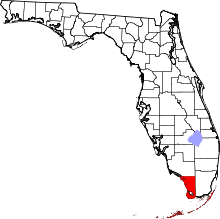Marathon, Florida
| Marathon, Florida | |
|---|---|
| City | |
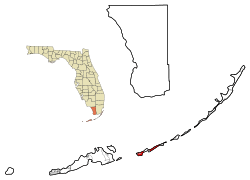 Location in Monroe County and the U.S. state of Florida | |
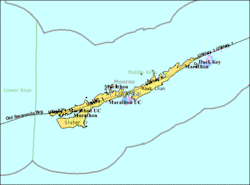 U.S. Census Bureau map showing city limits | |
| Coordinates: 24°43′35″N 81°2′25″W / 24.72639°N 81.04028°WCoordinates: 24°43′35″N 81°2′25″W / 24.72639°N 81.04028°W | |
| Country |
|
| State |
|
| County |
|
| Area[1] | |
| • Total | 9.27 sq mi (24.02 km2) |
| • Land | 8.44 sq mi (21.87 km2) |
| • Water | 0.83 sq mi (2.15 km2) |
| Elevation | 3 ft (1 m) |
| Population (2010) | |
| • Total | 8,297 |
| • Estimate (2016)[2] | 8,910 |
| • Density | 1,055.44/sq mi (407.50/km2) |
| Time zone | UTC-5 (Eastern (EST)) |
| • Summer (DST) | UTC-4 (EDT) |
| ZIP codes | 33050-33052 |
| Area code(s) | 305 |
| FIPS code | 12-43000[3] |
| GNIS feature ID | 0286401[4] |
Marathon is a city on Knight's Key, Boot Key, Key Vaca, Fat Deer Key, Long Point Key, Crawl Key and Grassy Key islands in the middle of the Florida Keys, in Monroe County, Florida, United States.[5] As of the 2000 census, the city had a total population of 10,255. As of 2014, the population estimated by the U.S. Census Bureau was 8,708.[6]
History
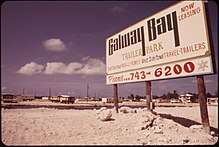
Though the area has been settled for some time, Marathon is a relatively new city, incorporated in 1999. Its boundaries (according to both the city and a 2001 Rand McNally road map of the Keys) extend from the east end of the Seven Mile Bridge (Mile Marker 47) to the west end of Tom's Harbor Bridge (Mile Marker 61), excluding that portion of the area within the city limits of Key Colony Beach. Among the islands within the city limits are Boot Key, Knight's Key, Hog Key, Vaca Key, Stirrup Key, Crawl Key, Little Crawl Key, East and West Sister’s Island, Deer Key, Fat Deer Key (excluding the portion in Key Colony Beach), Long Point Key, and Grassy Key.
The name Marathon dates back to the origin of the Florida East Coast Railroad. The name came from the railroad workers who were working night and day to complete the railway; due to the unrelenting pace and struggle to complete the project, workers complained that "this is getting to be a real marathon", and the word was later used to name the local railroad station.[7]
The Keys historian Dan Gallager in his book "Florida's Great Ocean Railway" credits New York playwright Wiiter Bynner for naming Marathon. According to Gallager, J.R. Parrott, then Florida East Coast Railway's President and General Manager, invited Brynner to the Keys to "plot stations for the railroad." When asked to generate a name for the station at Key Vaca, Brynner proposed "Marathon", inspired by the following passage from Byron: "The mountains look on Marathon — and Marathon looks on the sea."
Hurricane Irma
Marathon experienced significant damage from the September 10, 2017 U.S. landfall of Hurricane Irma. One of the earliest casualties of this storm was the death of a man who died in a school shelter.[8] Marathon will be one of the earliest spots in the Keys to receive transport of needed supplies to deal with the aftermath of Irma. The Air National Guard is expected to land two C-130 transport planes every two hours beginning in the morning of September 11.[9]
Geography
According to the United States Census Bureau, the city has a total area of 9.6 square miles (25 km2), of which 8.6 square miles (22 km2) is land and 1.0 square mile (2.6 km2) (10.37%) is water. Its city limits extend 1200' from land into the adjacent waters.[10]
Boot Key Harbor is a natural body of water between Boot Key and Key Vaca, entirely within the Marathon city limits.[11]
Climate
Marathon has a tropical savanna climate (Aw in the Köppen and Trewartha climate classifications). There is no record of snow/frost/freeze in Marathon. Like much of Florida and the Florida Keys, Marathon has two seasons; A hot and wet season from May through October, and a warm and dry season from November though April.
Demographics
| Historical population | |||
|---|---|---|---|
| Census | Pop. | %± | |
| 1970 | 4,397 | — | |
| 1980 | 7,568 | 72.1% | |
| 1990 | 8,857 | 17.0% | |
| 2000 | 10,255 | 15.8% | |
| 2010 | 8,297 | −19.1% | |
| Est. 2016 | 8,910 | [2] | 7.4% |
| U.S. Decennial Census[12] | |||
As of the census[3] of 2000, there were 10,255 people, 4,597 households, and 2,735 families residing in the city. The population density was 1,186.1 inhabitants per square mile (457.7/km²). There were 6,791 housing units at an average density of 785.4 per square mile (303.1/km²). The racial makeup of the city was 91.09% White, 4.65% African American, 0.36% Native American, 0.48% Asian, 0.04% Pacific Islander, 2.00% from other races, and 1.38% from two or more races. Hispanic or Latino of any race were 20.43% of the population. As of 2010, City-Data states racial makeup of the city was White alone - 5,508 (66.4%), Hispanic - 2,224 (26.8%), Black alone - 357 (4.3%), Asian alone - 90 (1.1%), Two or more races - 89 (1.1%), American Indian alone - 25 (0.3%), Native Hawaiian and Other Pacific Islander alone - 2 (0.02%), Other race alone - 2 (0.02%).[13]
There were 4,597 households out of which 34.8% had children under the age of 18 living with them, 48.0% were married couples living together, 7.5% had a female householder with no husband present, and 20.5% were non-families. 29.2% of all households were made up of individuals and 8.6% had someone living alone who was 65 years of age or older. The average household size was 2.19 and the average family size was 2.68.
In the city, the population was spread out with 17.3% under the age of 18, 6.1% from 18 to 24, 28.6% from 25 to 44, 32.0% from 45 to 64, and 16.0% who were 65 years of age or older. The median age was 44 years. For every 100 females, there were 110.6 males. For every 100 females age 18 and over, there were 111.7 males.
The median income for a household in the city was $36,010, and the median income for a family was $46,361. Males had a median income of $27,057 versus $24,592 for females. The per capita income for the city was $22,894. About 9.4% of families and 14.2% of the population were below the poverty line, including 10.9% of those under age 18 and 13.5% of those age 65 or over.
As of 2000, English as a first language accounted for 78.10%, while Spanish as a mother tongue made up 20.95% of the population.[14]
Churches
- San Pablo Catholic Church
- Church of Christ
- Marathon Community United Methodist Church
- New Life Assembly of God
- St Columba Episcopal Church
- Marathon Seventh Day Adventist
- First Baptist Church
- The Church of Jesus Christ of Latter-Day Saints
- Marathon Church of God
- Calvary Baptist Church
- Kirk of the Keys (Covenant Order Evangelical Presbyterian-ECO)
- Jehovah's Witnesses Kingdom Hall
- Martin Luther Chapel
- Marathon Baptist Church
- Saint Paul A.M.E Church
Economy
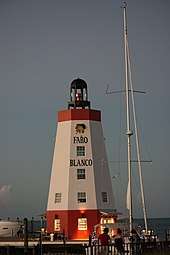
Marathon is a major sport fishing destination, with several charter fishing boats departing from local marinas every morning to both the Gulf of Mexico and the Atlantic Ocean. Bountiful reefs around Marathon make it a popular diving, snorkeling, spearfishing, and lobster tickling area. One of the last untouched tropical hardwood hammocks in the Keys is found at Crane Point Museum, just a few miles west of Florida Keys Marathon Airport. The vicinity of the airport is one of the most reliable sites in the United States to see the hard-to-find Antillean nighthawk. As in the rest of the Keys in summer, gray kingbirds are often seen on telephone wires along US 1 and black-whiskered vireos incessantly sing in the hammocks. Marathon also hosts burrowing owls.
The Fisherman's Hospital is in the west end of the city. It is one of just three hospitals in the Florida Keys. Marathon is home to another "hospital", The Turtle Hospital, one of a handful of facilities in the United States that rescue, rehabilitate, and release injured sea turtles.
Marathon derives much of its livelihood from the ocean and seafood is a staple at most restaurants. There are many restaurants, including the Overseas Bar and Grill, The Island Tiki Bar and Grill, Lazy Days South, Burdines, Keys Fisheries, Castaway, The Sunset Grill, The Stuffed Pig and Marathon Bagel Shop.
Marathon has the tallest building in the Keys, Bonefish Tower at 143 feet (44 m) on Coco Plum, as well as Sombrero Country Club, the Keys' only country club. It was damaged by several recent hurricanes. With the redevelopment of the Faro Blanco property with a new Hyatt Place Hotel, restaurant and marina, and the redevelopment of the former Ramada Inn hotel into a new Hampton Inn and Suites hotel, Marathon is experiencing a social and economic rebirth.
Arts and culture
Library
A branch of the Monroe County Public Library is in Marathon.[15]
Education
Residents are zoned to schools in the Monroe County School District.
Schools
- Stanley Switlik Elementary (K-5 center)
- Marathon Middle/High School
- Martin Luther Children's Day School
- Kreative Kids Christian Academy
Notable people
- Gary Burghoff (Radar from the TV series M*A*S*H)
- Nick Carter (Backstreet Boys member)
- Kenny G (musician)
- Bruce Willis & Demi Moore (actors)
- Tony Bryant (Former NFL player)
- Max Yasgur (Woodstock's farmer legend)
- Stanley Switlik (Switlik Parachute Company)
- Clarence Clemons (E Street Band saxophonist)
See also
References
- ↑ "2016 U.S. Gazetteer Files". United States Census Bureau. Retrieved Jul 7, 2017.
- 1 2 "Population and Housing Unit Estimates". Retrieved June 9, 2017.
- 1 2 "American FactFinder". United States Census Bureau. Retrieved 2008-01-31.
- ↑ "US Board on Geographic Names". United States Geological Survey. 2007-10-25. Retrieved 2008-01-31.
- ↑ Zepke, T. (2017). Terrance Talk Travel: A Pocket Guide to the Florida Keys: Including The Everglades & Key West. Terrance Talks Travel. Safari Publishing. p. pt57. ISBN 978-1-942738-25-1. Retrieved September 7, 2017.
- ↑
- ↑ History of Marathon
- ↑ Goodhue, David. City of Marathon: ‘Everything is under water, I mean everything’. flkeysnews.com September 10, 2017. Accessed September 10, 2017.
- ↑ Goodhue, David. Massive airborne relief mission on way to the Keys to help with ‘humanitarian crisis’. flkeysnews.com September 10, 2017. Accessed September 10, 2017.
- ↑ City of Marathon Charter Archived 2006-10-04 at the Wayback Machine.
- ↑ City of Marathon - Boot Key Harbor City Marina Archived 2007-05-03 at the Wayback Machine.
- ↑ "Census of Population and Housing". Census.gov. Retrieved June 4, 2015.
- ↑ "Marathon, Florida (Fla. 33050) profile: population, maps, real estate, averages, homes, statistics, relocation, travel, jobs, hospitals, schools, crime, moving, houses, news, sex offenders". City-data.com. Retrieved 2012-12-18.
- ↑ Modern Language Association Data Center Results of Marathon, Florida
- ↑ "About the Marathon Library". Monroe County Public Library. Retrieved April 18, 2017.
External links
| Wikimedia Commons has media related to Marathon, Florida. |
